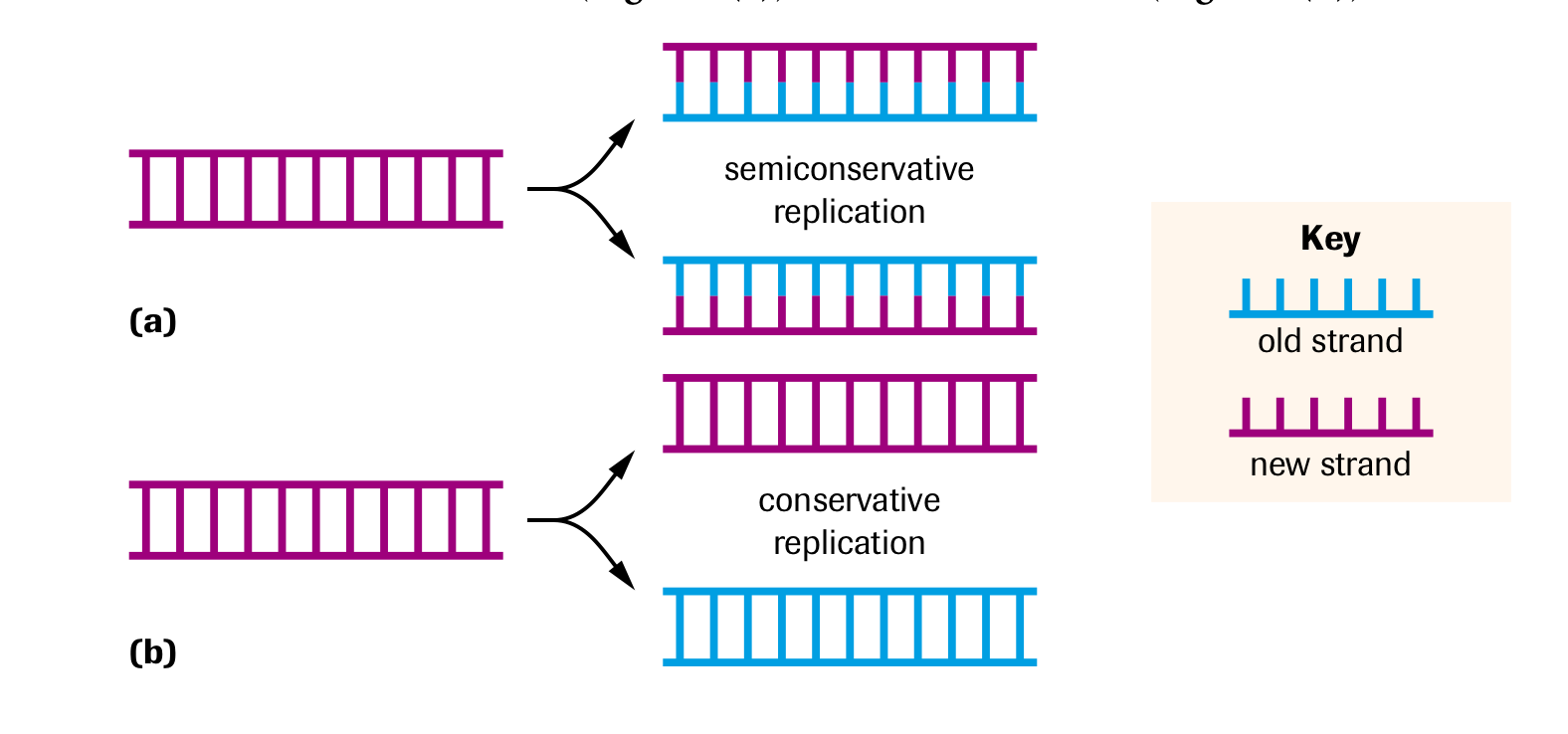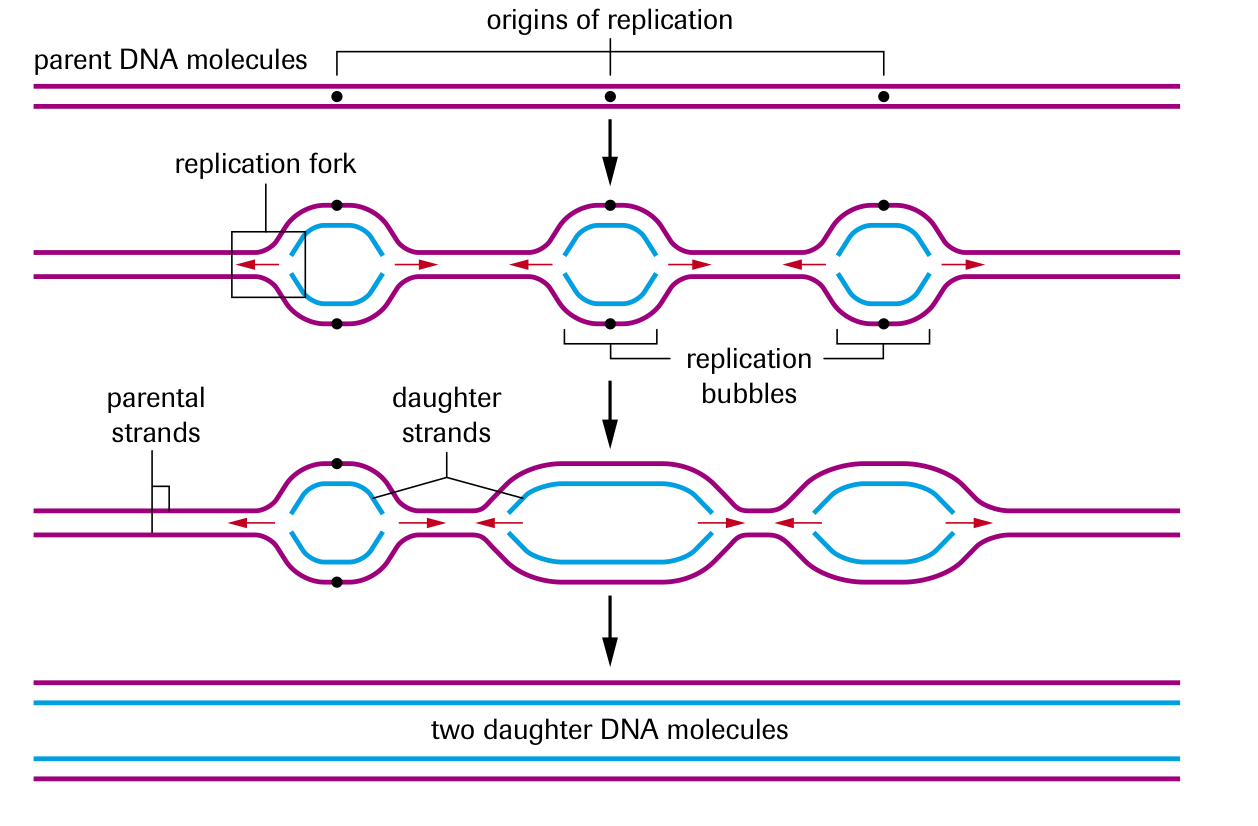
DNA replication (H14)
Name and state the functions of the five main enzymes required in DNA replication
Name the five main enzymes required in DNA replication - Helicase, Gyrase, Primase, DNA ploymerase III, DNA ploymerase I
Function of Helicase - the enzyme that unwinds double-helical DNA by disrupting hydrogen bonds
Function of Gyrase - the enzyme that relieves the tension produced by unwinding of DNA during replication
Function of DNA polymerase III - the enzyme responsible for synthesizing complementary strands of DNA during DNA replication
Function of Primase - the enzyme that build RNA primers
Function of DNA polymerase I - an enzyme that removes RNA primers and replaces them with appropriate deoxyribonucleotides during DNA replication
DNA replication is semiconservative

Why cant the 2 halves of DNA be replicated exactly the same way? - If DNA were to replicate conservatively (the exact same), one daughter molecule would be unchanged from the parent molecule and one daughter molecule would consist of newly synthesized strands
What are 2 terms used to differentiate the 2 strands? - Leading strand and lagging strand
Define leading strand - the new strand of DNA that is synthesized continuously during DNA replication
Define lagging strand - the new strand of DNA that is synthesized in short fragments, which are later joined
How are the nucleotides added, on the lagging strand - Complementary strand is built away from replication fork, Built discontinuously in small sections known as Okazaki fragments, Primase continuously adds primers as replication fork travels along DNA molecule , Gaps between Okazaki fragments are joined by DNA ligase
What are the “origins of replication”? - They are the replication fork and the replication bubble
What is the replication fork?- the region where the enzymes replicating a DNA molecule are bound to untwisted single-stranded DNA
What is the replication bubble? - the region where 2 replication forks are in close proximity to each other, producing a bubble in the replicating DNA

A replication fork is the region where the enzymes replicating a DNA molecule are bound to the untwisted, single stranded DNA, whereas a replication bubble is formed when two replication forks are in close proximity to each other, resulting in a bubble of single-stranded DNA between them.
What is meant by the semi-conservative model of replication? How did the Meselson-Stahl experiment support this ?
DNA replication (H14)
Name and state the functions of the five main enzymes required in DNA replication
Name the five main enzymes required in DNA replication - Helicase, Gyrase, Primase, DNA ploymerase III, DNA ploymerase I
Function of Helicase - the enzyme that unwinds double-helical DNA by disrupting hydrogen bonds
Function of Gyrase - the enzyme that relieves the tension produced by unwinding of DNA during replication
Function of DNA polymerase III - the enzyme responsible for synthesizing complementary strands of DNA during DNA replication
Function of Primase - the enzyme that build RNA primers
Function of DNA polymerase I - an enzyme that removes RNA primers and replaces them with appropriate deoxyribonucleotides during DNA replication
DNA replication is semiconservative

Why cant the 2 halves of DNA be replicated exactly the same way? - If DNA were to replicate conservatively (the exact same), one daughter molecule would be unchanged from the parent molecule and one daughter molecule would consist of newly synthesized strands
What are 2 terms used to differentiate the 2 strands? - Leading strand and lagging strand
Define leading strand - the new strand of DNA that is synthesized continuously during DNA replication
Define lagging strand - the new strand of DNA that is synthesized in short fragments, which are later joined
How are the nucleotides added, on the lagging strand - Complementary strand is built away from replication fork, Built discontinuously in small sections known as Okazaki fragments, Primase continuously adds primers as replication fork travels along DNA molecule , Gaps between Okazaki fragments are joined by DNA ligase
What are the “origins of replication”? - They are the replication fork and the replication bubble
What is the replication fork?- the region where the enzymes replicating a DNA molecule are bound to untwisted single-stranded DNA
What is the replication bubble? - the region where 2 replication forks are in close proximity to each other, producing a bubble in the replicating DNA

A replication fork is the region where the enzymes replicating a DNA molecule are bound to the untwisted, single stranded DNA, whereas a replication bubble is formed when two replication forks are in close proximity to each other, resulting in a bubble of single-stranded DNA between them.
What is meant by the semi-conservative model of replication? How did the Meselson-Stahl experiment support this ?
 Knowt
Knowt